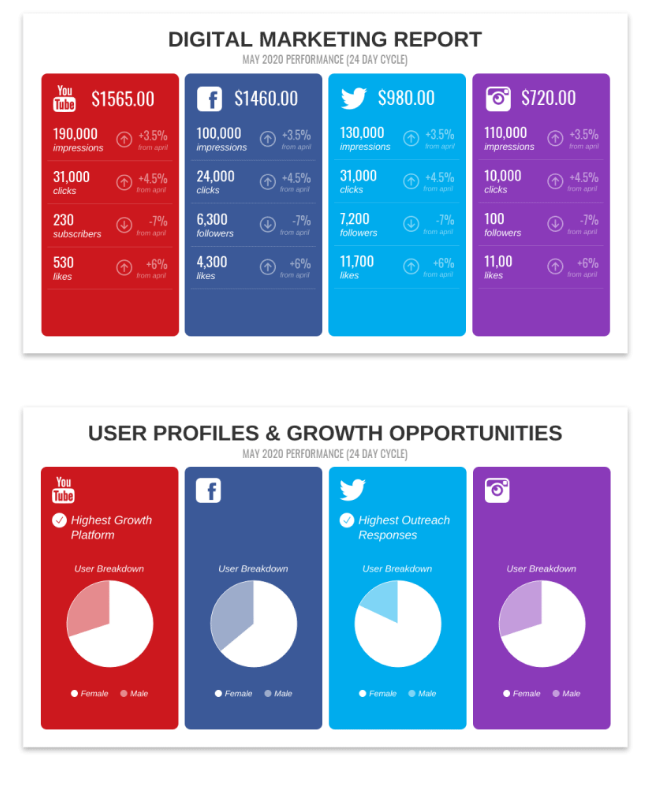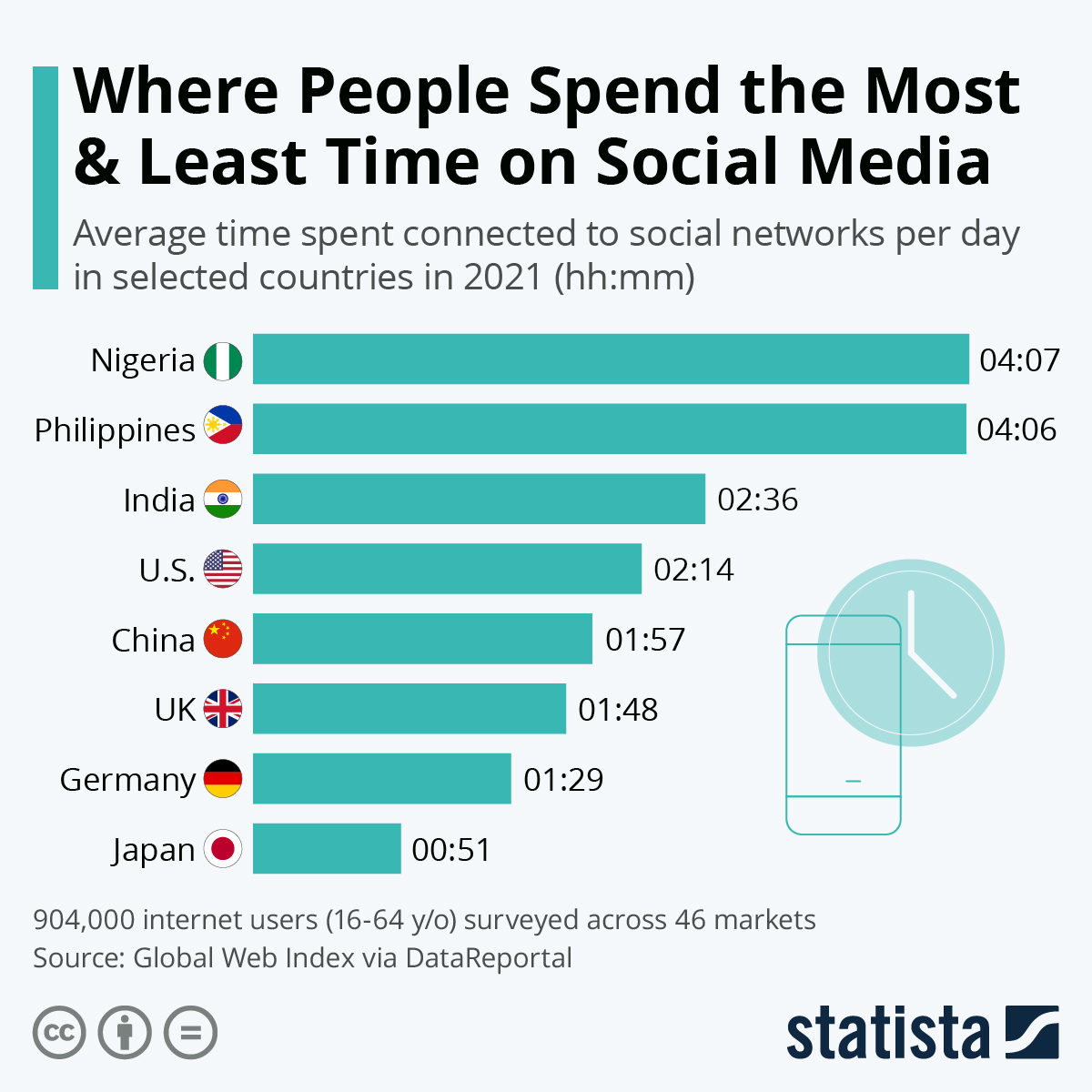
You can create an impressive social media reporting tool if the tools you use to report on social media are right. This article will discuss how to make a social media report, what information to include, when to report it, and which KPIs you should use. You'll be able to deliver effective social media reports to all your stakeholders after reading this article. Start today! Continue reading! Let us walk you through it step-by-step.
Social media reporting tools
B2B companies often focus on the ROI of social media. Larger brands tend to be more focused on reach. Consider your current processes, potential future plans, as well as templates. Many tools only function at certain levels so be sure to select the right one for you. These tools can be used as affiliate links and may not suit all companies. Read on for a few tools that can be used for social media reporting.
Social media tools that automatically pull data directly from multiple sources are some of the best. Google Analytics offers a data connector, which lets you view all of the data from one source. Datapine is another option that allows you to compare and visualize metrics across different platforms. These tools will automatically update social media reports with the latest results. This is the ideal tool for anyone who wants to easily see their social media reports visually.

Include information in your social media report
A social media report should outline the main goals of a campaign as well as the metrics that were used for measuring success. The client's objectives should be reflected in the report. Instead of presenting data on only the lowest metric possible, instead focus on the highest-value metrics, like impressions and conversions. These are some helpful tips to help you decide what information to include in a social media report. These tips will assist you in making the most of your social networking campaigns.
Carefully choose metrics. There are many metrics on social media platforms. It can be overwhelming to pick the most important metrics to include in your report. Choose metrics that are specific to your goals and purpose, and don't include metrics that have no value for you. A social media report template can help you determine which metrics to include. Consider the audience you are writing about.
Time frame for a social-media report
Social media reporting should have a defined time period. For example, every 30 days. This is helpful for judging the overall performance of a campaign. It can also help to evaluate work-in progress and identify areas for improvement. For consistency and to be of use to the business, reports should always be sent out on an ongoing basis. However, reporting should be focused on metrics.
Report on your social media activities and include metrics. You can also compare your data with previous years and to the same week. The week can be compared to the previous week and last month. Highlighting successful campaigns will help you identify growth opportunities. It is also helpful if you include a summary of key elements of your reporting. Automate your reporting process if possible. This will allow you to automate the updating of information.

KPIs to include into a social network report
When generating a social media report, it is essential to understand what the objectives are and then decide what KPIs to include in the document. Social media reports may contain data from multiple platforms. Before you start implementing metrics, think about the questions you need answered. Some metrics are shared across platforms while others are unique for each platform. No matter the platform, it's important to create a social network report that is visually appealing. It should also reflect your business goals.
The key KPIs you need to measure success in social media reporting should be included. Share of voice, which measures brand attention relative to other competitors, is a key KPI. You can gauge the popularity of your brand by knowing how often it is mentioned online in discussions about your industry. Although this KPI may seem insignificant at first glance, it can help you measure your business's performance.
FAQ
How do I get started in Content Marketing?
Your audience is the first step. Who are they? What are their needs? How can you help them? Knowing who you are writing for will help you decide where to put your efforts.
What are some of the benefits of content-marketing?
Content marketing helps drive leads and sales by creating high-quality content. Content marketing also provides a steady stream of fresh, original content that can be used to promote products and services. Content marketing helps increase brand awareness, trust and engagement among potential customers. Finally, content marketing creates a positive image for your company.
What are the differences between content strategies?
Content strategy can be described as a broad term that covers all aspects of creating, managing, distributing, measuring, and optimizing content for digital channels. This includes not only what you post on social media sites like Facebook and Twitter, but also what you highlight on your website, blog and other online properties.
Content strategy is important as it lets you know where your attention should go, what content you should use, how to communicate your messages to your audience, and which types of content you should use.
It is about understanding how content fits within the overall business goals to help you achieve them.
How effective is content-marketing?
Yes! Hubspot states that Content Marketing is now the number one digital marketing channel for lead generation.
How long can I expect my content-marketing campaign to last?
It depends on the industry and what type of product or service is being offered.
You might spend one to three months designing a new pair of shoes if you are selling shoes. You might launch the new product in August, and then keep it updated throughout the year.
If you're selling clothing, you might design one look for fall and another for spring. You should always offer something new to your audience so they never get bored.
Your goals determine the length of your content marketing campaign. You may only need one channel for small businesses. For larger companies, you may need to consider multiple channels to reach a broad target audience.
What is Content Marketing Strategy?
Content Marketing Strategy gives access to data you might not otherwise be able to. This data allows for you to evaluate which types of content are performing better than others.
It can help you decide which strategies are best to drive traffic to you site. It gives you insight into your audience to help you develop better content.
This means you can spend less time worrying about what kind of content works and more time focusing on what doesn't.
A Content Marketing Strategy can help you determine what messages resonate best with your audience.
You can find out their preferred content by analysing these messages. So that you can continue creating similar content and keeping those ideas in motion.
A Content Marketing Strategy can help you track the performance of your content. As you continue sharing different content types, you can easily see which ones convert better.
A Content Marketing Strategy can be summarized as the key to ensuring that your content performs well.
Statistics
- Out of the 1,500 marketers we surveyed for our State of Content Marketing report, 78% who felt their content marketing strategy was exceptionally effective in 2021 had documented their strategy. (semrush.com)
- Measure your goals with a progress indicator of 0-100%. Make your goals collaborative and transparent (semrush.com)
- Progress indicators (0–100%) allow each team member to see how attainable each goal is and understand what remains to be accomplished. (semrush.com)
- Seventy-two percent business to business (B2B) (mailchimp.com)
- Forty-seven percent of buyers view 3 to 5 pieces of content before engaging with a sales representative. (mailchimp.com)
- In fact, would pay more for a better customer experience, and 86% of B2B buyers would pay more. (neilpatel.com)
- Companies that use content marketing see approximately 30% higher growth rates than businesses not using it. (mailchimp.com)
- According to our research, brand awareness, attracting traffic, and generating leads remain the key content marketing goals in 2022. (semrush.com)
External Links
How To
Content Marketing Tips: Infographic Creation Tips
Infographics make complex concepts simple and easy to understand. Infographics can be used to communicate your message.
For creating an infographic you'll need software such as Adobe Illustrator and Photoshop. You can use these programs to draw out different shapes and elements to represent your data, then add colors and fonts to make everything look nice. Once you have your design ready, upload images from Unsplash or Pixabay to add to it.
Looking at other infographics online can help you get ideas. You could use a photo of a food pyramid to show the calories in particular foods. Then, replace those numbers with photos of the foods. Another option is to take a picture of a can of Coke and look at how much sugar it contains.
After you have created your infographic, it can be shared through social media channels such as Facebook and Twitter. This helps people who aren't familiar with the concept learn about it. You can include hashtags in your infographic if you want to share it on social media. Users can follow along with specific conversations using hashtags.
If you decide to create an infographic, try making your posts shorter than usual. An average blog post will be between 2000 and 5000 words. An infographic, however, only needs 500 to 1000 words. This means that you can convey more information in a shorter space.
Keep in mind that viewers may have difficulty reading small fonts when creating your infographic. It is important to use large fonts and avoid relying too heavily on colors when designing your infographic. You must also ensure that your text is easily read.
Here are some more tips
-
Use an infographic template. There are many online templates that you can download or print. Canva (Piktochart) and Google Slides (Google Slides) are some of the most requested templates.
-
Create your Infographic. Create your infographic using the template. You can use any type of media that is appropriate for your audience. In this example, photos of Seattle restaurants might be used to create an infographic about Seattle's best restaurants.
-
Add text. Add text after you've created your infographic.
-
Add Images. You can also add images to your infographic. These images can be charts, graphs, icons, or pictures. Make sure the picture is relevant to your topic before you add it.
-
Make it interactive. Interactive elements can include buttons, maps, or links. This will make it easier for your audience to interact with you.
-
Share. Share your infographic after you're done.
-
Measure. How well did your infographic perform? Did people click through? Did they sign up for your email list? Was your infographic received well by them?
-
Improve. Do you have any suggestions for improving your infographics? Could you do better next time?
-
Repeat. Repeat.